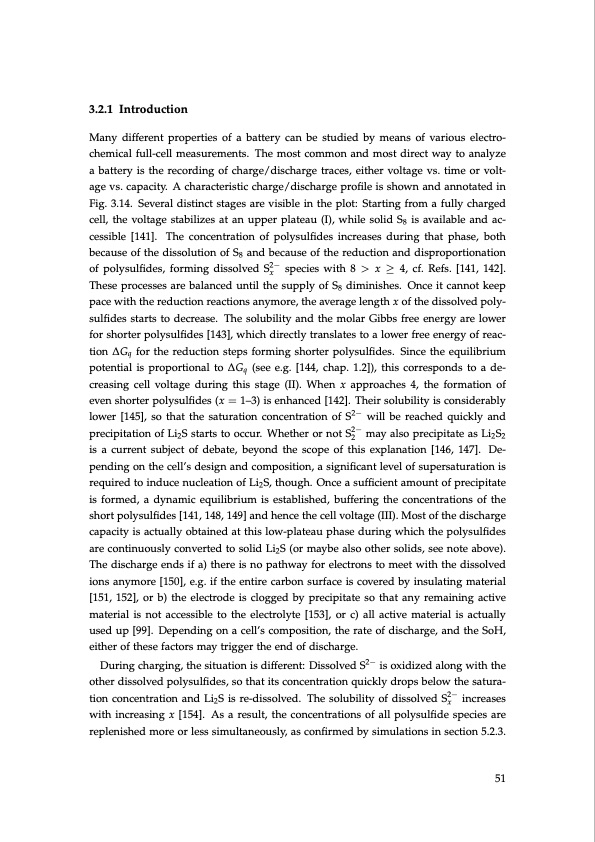
PDF Publication Title:
Text from PDF Page: 051
3.2.1 Introduction Many different properties of a battery can be studied by means of various electro- chemical full-cell measurements. The most common and most direct way to analyze a battery is the recording of charge/discharge traces, either voltage vs. time or volt- age vs. capacity. A characteristic charge/discharge profile is shown and annotated in Fig. 3.14. Several distinct stages are visible in the plot: Starting from a fully charged cell, the voltage stabilizes at an upper plateau (I), while solid S8 is available and ac- cessible [141]. The concentration of polysulfides increases during that phase, both because of the dissolution of S8 and because of the reduction and disproportionation of polysulfides, forming dissolved S2− species with 8 > x ≥ 4, cf. Refs. [141, 142]. x These processes are balanced until the supply of S8 diminishes. Once it cannot keep pace with the reduction reactions anymore, the average length x of the dissolved poly- sulfides starts to decrease. The solubility and the molar Gibbs free energy are lower for shorter polysulfides [143], which directly translates to a lower free energy of reac- tion ∆Gq for the reduction steps forming shorter polysulfides. Since the equilibrium potential is proportional to ∆Gq (see e.g. [144, chap. 1.2]), this corresponds to a de- creasing cell voltage during this stage (II). When x approaches 4, the formation of even shorter polysulfides (x = 1–3) is enhanced [142]. Their solubility is considerably lower [145], so that the saturation concentration of S2− will be reached quickly and precipitation of Li2S starts to occur. Whether or not S2− may also precipitate as Li2S2 2 is a current subject of debate, beyond the scope of this explanation [146, 147]. De- pending on the cell’s design and composition, a significant level of supersaturation is required to induce nucleation of Li2S, though. Once a sufficient amount of precipitate is formed, a dynamic equilibrium is established, buffering the concentrations of the short polysulfides [141, 148, 149] and hence the cell voltage (III). Most of the discharge capacity is actually obtained at this low-plateau phase during which the polysulfides are continuously converted to solid Li2S (or maybe also other solids, see note above). The discharge ends if a) there is no pathway for electrons to meet with the dissolved ions anymore [150], e.g. if the entire carbon surface is covered by insulating material [151, 152], or b) the electrode is clogged by precipitate so that any remaining active material is not accessible to the electrolyte [153], or c) all active material is actually used up [99]. Depending on a cell’s composition, the rate of discharge, and the SoH, either of these factors may trigger the end of discharge. During charging, the situation is different: Dissolved S2− is oxidized along with the other dissolved polysulfides, so that its concentration quickly drops below the satura- tion concentration and Li S is re-dissolved. The solubility of dissolved S2− increases 2x with increasing x [154]. As a result, the concentrations of all polysulfide species are replenished more or less simultaneously, as confirmed by simulations in section 5.2.3. 51PDF Image | Lithium-Sulfur Battery: Design, Characterization, and Physically-based Modeling

PDF Search Title:
Lithium-Sulfur Battery: Design, Characterization, and Physically-based ModelingOriginal File Name Searched:
Dissertation_David_N._Fronczek_The_Lithium_Sulfur_Battery.pdfDIY PDF Search: Google It | Yahoo | Bing
Sulfur Deposition on Carbon Nanofibers using Supercritical CO2 Sulfur Deposition on Carbon Nanofibers using Supercritical CO2. Gamma sulfur also known as mother of pearl sulfur and nacreous sulfur... More Info
CO2 Organic Rankine Cycle Experimenter Platform The supercritical CO2 phase change system is both a heat pump and organic rankine cycle which can be used for those purposes and as a supercritical extractor for advanced subcritical and supercritical extraction technology. Uses include producing nanoparticles, precious metal CO2 extraction, lithium battery recycling, and other applications... More Info
| CONTACT TEL: 608-238-6001 Email: greg@infinityturbine.com | RSS | AMP |